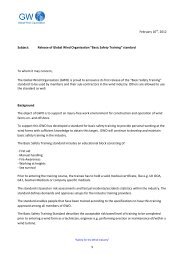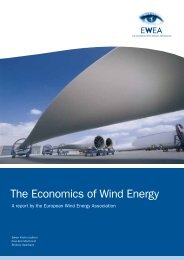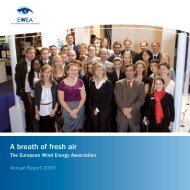Offshore Electricity Infrastructure in Europe - European Wind Energy ...
Offshore Electricity Infrastructure in Europe - European Wind Energy ...
Offshore Electricity Infrastructure in Europe - European Wind Energy ...
You also want an ePaper? Increase the reach of your titles
YUMPU automatically turns print PDFs into web optimized ePapers that Google loves.
are generally lower because the cable length can<br />
be vastly reduced: <strong>in</strong>dividual connection to shore<br />
is expensive, the w<strong>in</strong>d farm to hub connection and<br />
the bundled hub-to-shore connection with a large<br />
capacity are cheaper.<br />
• Hub-to-hub solutions become more beneficial when:<br />
– Price differences between countries are low,<br />
– Countries are far from each other but w<strong>in</strong>d farm<br />
hubs are close (high cost sav<strong>in</strong>gs),<br />
– The w<strong>in</strong>d farm capacity, and thus its connection<br />
to shore, is high compared to the <strong>in</strong>terconnector<br />
capacity (low constra<strong>in</strong>ts),<br />
– The w<strong>in</strong>d power is <strong>in</strong>versely correlated with<br />
the price difference (high w<strong>in</strong>d power, low price<br />
difference).<br />
• In many cases the w<strong>in</strong>d farm hubs will be built first<br />
to connect national w<strong>in</strong>d farms. The <strong>in</strong>terconnection<br />
between the hubs is then built later and should<br />
be dimensioned consider<strong>in</strong>g the price levels <strong>in</strong> the<br />
countries the hubs are connected to. This is because<br />
most of the time the power would flow from<br />
the hub <strong>in</strong> the country with the lower price to the<br />
hub <strong>in</strong> the country with the higher price. Of course it<br />
would be optimal to additionally dimension the hub<br />
connection cables accord<strong>in</strong>g to these considerations,<br />
as <strong>in</strong> the case of the “split-cable-connection”.<br />
But this is only possible <strong>in</strong> the ideal case when the<br />
hub-to-hub connection is taken <strong>in</strong>to account at the<br />
very beg<strong>in</strong>n<strong>in</strong>g of the project plann<strong>in</strong>g.<br />
• Ideally, the hub-to-hub connection would be planned<br />
from scratch which allows the hub-to-shore and<br />
hub-to-hub connections to be dimensioned accord<strong>in</strong>g<br />
to expected price levels <strong>in</strong> the <strong>in</strong>terconnected<br />
countries. In general this would mean that the hubto-shore<br />
connection should be dimensioned larger<br />
<strong>in</strong> the country with the higher price level. This is<br />
<strong>in</strong> l<strong>in</strong>e with the power flow as an additional power<br />
trade from the country with the higher price level<br />
would be beneficial.<br />
• For meshed grid nodes with more than two l<strong>in</strong>es<br />
com<strong>in</strong>g together, similar conclusions can be drawn.<br />
The l<strong>in</strong>ks to the country with the highest prices<br />
(over the lifetime) should be largest, and the other<br />
ones can be smaller <strong>in</strong> dimension. The most efficient<br />
solution would occur if the sum of all country<br />
connection cable capacities equals the sum of the<br />
<strong>Offshore</strong>Grid – F<strong>in</strong>al Report<br />
connected w<strong>in</strong>d farms. This way the additional <strong>in</strong>vestment<br />
<strong>in</strong> <strong>in</strong>tegrated platforms and jo<strong>in</strong>ts br<strong>in</strong>gs<br />
<strong>in</strong>terconnection between three countries. If larger<br />
<strong>in</strong>terconnection capacity is needed, some of the<br />
cables can be oversized.<br />
• Concrete guidel<strong>in</strong>es for pre-feasibility analysis on<br />
hub-to-hub solutions have been def<strong>in</strong>ed and can be<br />
found on www.offshoregrid.eu.<br />
Recommendations on hub-to-hub solutions<br />
• When hub connections for offshore w<strong>in</strong>d farms are<br />
developed, the plans should be reviewed by the TSO<br />
<strong>in</strong> order to identify possible connection options to<br />
other w<strong>in</strong>d farms hubs or countries for which there<br />
is demand for <strong>in</strong>ternational exchange.<br />
• Equally, when develop<strong>in</strong>g <strong>in</strong>terconnectors, TSOs<br />
should review the identified concession areas for<br />
offshore w<strong>in</strong>d and consider the option of develop<strong>in</strong>g<br />
a hub <strong>in</strong> such an area as a start<strong>in</strong>g po<strong>in</strong>t for the<br />
<strong>in</strong>terconnector.<br />
• If feasible options have been identified, the offshore<br />
grid developer should carry out a detailed feasibility<br />
and pre-design study <strong>in</strong> view of an optimal dimension<strong>in</strong>g<br />
of the <strong>in</strong>tegrated solution. This may <strong>in</strong>clude<br />
<strong>in</strong>creas<strong>in</strong>g the rat<strong>in</strong>g of the hub connection to shore<br />
<strong>in</strong> order to satisfy the required demand for <strong>in</strong>ternational<br />
exchange. As for tee-<strong>in</strong> solutions, the focus<br />
should be on <strong>in</strong>creas<strong>in</strong>g the capacity on the side of<br />
the country which usually has the highest prices.<br />
• <strong>Offshore</strong> grid development should be a jo<strong>in</strong>t or, at<br />
least, coord<strong>in</strong>ated activity of the developers of the<br />
w<strong>in</strong>d farms and their hubs connections, and TSOs.<br />
• The North and Baltic Sea countries should adapt<br />
their regulatory frameworks to foster such a coord<strong>in</strong>ated<br />
approach.<br />
• When look<strong>in</strong>g at the <strong>in</strong>terconnection of two hubs <strong>in</strong><br />
different countries: In the case that the hubs are<br />
built first and the hub-to-hub connection is added<br />
later on to the exist<strong>in</strong>g w<strong>in</strong>d farm hubs, there is<br />
not much need of additional <strong>in</strong>ternational coord<strong>in</strong>ation.<br />
In such a case the <strong>in</strong>terconnection would be<br />
comparable to an onshore cross-border <strong>in</strong>terconnection<br />
<strong>in</strong> terms of its legal, regulatory and political<br />
complexity.<br />
93









